Medicinal Properties of Nardostachys jatamansi (A Review)
Renu Sahu*, H. J. Dhongade, Ajit Pandey, Poonam Sahu, Varsha Sahu, Dipali Patel and Pranita Kashyap
Department of Phytopharmacognosy, Shri Rawatpura Sarkar Institute of Pharmacy, Kumhari, Durg, C.G, (India) Corresponding author email: hemantdhongade@gmail.com
DOI : http://dx.doi.org/10.13005/ojc/320211
Article Received on :
Article Accepted on :
Article Published : 15 Apr 2016
Nardostachys jatamansi DC. is an endangered, primitive and therapeutic herbal agent belonging to family Valerianaceae. The rhizomes of this hairy, perennial, dwarf and herbaceous plant are used for therapeutic effect in ayurvedic and unani system of medicine. Nardostachys jatamansi has been reported to have many therapeutic activities like antifungal, antimicrobial, antioxidant, hepatoprotective and cardio protective properties. It is used in the treatment of insomnia and CNS disorders. The vasodilator, bronchodilator, spasmolytic and platelet aggregation inhibition activities of the plant have also been reported. Jatamansone, nardostachone and actinidine are the major secondary metabolites present in the plant. This review article is summary of the potential benefits of this medicinal plant as reported in literature. The review also highlights the need for the use of this plant in Ayurvedic system of medicine and future prospects for further research.
KEYWORDS:Immunomodulator; Jatamansi; Jatamansone; Nardostachys jatamansi
Download this article as:| Copy the following to cite this article: Sahu R, Dhongade H. J, Pandey A, Sahu P, Sahu V, Patel D, Kashyap P. Medicinal Properties of Nardostachys jatamansi (A Review). Orient J Chem 2016;32(2) |
| Copy the following to cite this URL: Sahu R, Dhongade H. J, Pandey A, Sahu P, Sahu V, Patel D, Kashyap P. Medicinal Properties of Nardostachys jatamansi (A Review). Orient J Chem 2016;32(2). Available from: http://www.orientjchem.org/?p=15336 |
Introduction
Nardostachys jatamansi DC is a small perennial, rhizomatous herb which grows in steep, moist, rocky, undisturbed grassy slopes of India, Nepal, China and Bhutan from 2300 m to 6000 m above sea level. Polyploidy occurs in V. officinalis and there are diploid, tetraploid and octaploid types. The long sessile and oblong-ovate leaves are 15 to 20 cm in length. Flowers are slightly blue or pink in dense cymes. The root of this taxon consist of short, thick, dark grey rhizomes crowned with reddish brown tufted fibrous remains of the petioles of the radical leaves. Its rhizomes are used in traditional medicines in different medicinal system. It is used as a good stimulant, antispasmodic, tonic, laxative and antiepileptic [1]. Jatamansi has been traditionally used in treatment of wide range of disorders, which include digestive system, circulatory system, nervous system, respiratory system, urinary system, reproductive system and skin diseases. It also shows marked tranquillizing activity, hypotensive, hypolipidemic, hepatoprotective, neuroprotective, anti-ischemic, antiarrhythmic and anticonvulsant activities. The roots and rhizomes of Nardostachys jatamansi have been used to treat hysteria, syncope epilepsy, and mental weakness. It also exhibits cardio protective activity and used in the treatment of neural diseases. The essential oil obtained from the roots shows various pharmacological activities including antimicrobial, antifungal, hypotensive, anti-arrhythmic and anticonvulsant activity. Sesquiterpene is the major component of N. jatamansi plant, and also include jatamansone, nardostachone. The present article summarizes review on plant, its phytochemistry and pharmacological activities which have been reported [2].
Botanical Profile [3]
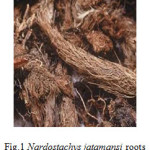 |
Figure 1: Nardostachys jatamansi roots |
Botanical classification of the plants is given below-:
Kingdom – Plantae
Division – Mangnoliophyta
Class – Mangnoliopsida
Order – Dipsacales
Family – Valerianaceae
Genus – Nardostachys
Species – Jatamansi
Botanical name – Nardostachys jatamansi DC
Part used – Rhizomes, Rhizome oil
Chemical Constituents
Nardostachys jatamansi consist of following chemical constituents-:
Alpha-patchoulenese, angelicin, beta-eudesemol, beta-patchoulenese, beta-sitosterol, calarene, calarenol, elemol, jatamansin, jatamansinol, jatamansone, n-hexacosane, n-hexacosanol, n-hexacosanyl arachidate, n-hexacosanyl isolverate, nardol, nardostechone, norsechelanone, oroselol, patchouli alcohol, seychelane, seychellene, valeranal, valeranone. Volatile essential oil, resins, sugar, starch, bitter extractive matter, gum, ketone, sesqueterpin ketone, spirojatamol etc [4,5]. Other sesquiterpenes include nardin, nardal, jatamnsic acid, b- maline and patchouli alcohol [6]. Various other sesquiterpenes known are nardostachone, dihydrojatamansin, jatamansic acid [7], jatamansinone, oroseolol, oroselone, seselin, nardostachyin, nardosinone, spirojatamol [8], jatamol A and B [9], calarenol [10], seychellene, seychelane, coumarin: xanthogalin [11]. An alkaloid named actinidine has also been reported. Nardal has been found as an active component [12].
Structure of chemical constituents
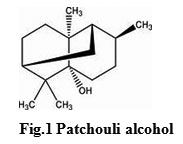
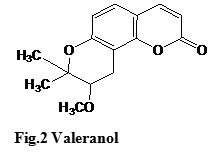
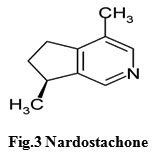
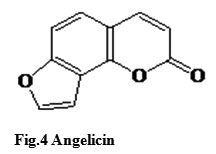
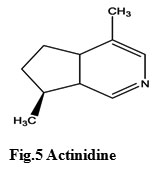
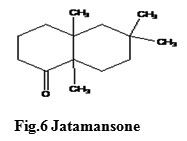
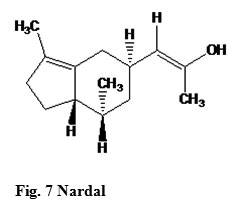
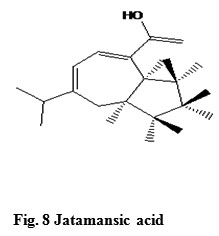
Pharmacological Studies
Hepatoprotective activity
Pre-treatment of rats with 800 mg/kg, p.o. of the 50% ethanolic extract of the rhizomes of N. jatamansi significantly lowered the elevated levels of serum transaminases [aminotransferases] and alkaline phosphatase in thioacetamide treated group of animals. The hepatoprotective activity was shown by the normalization of various serum enzymes elevated in response to thioacetamide-induced liver damage [13].
Antidepressant activity
The antidepressant activity of methanolic extract of N. Jatamansi by forced swim test, tail suspension test and locomotors activity in inbred male Swiss was determined. The efficacy of the extract at the dose of 200 and 400 mg/kg, p. o. was compared with the standard drug imipramine [10 mg/kg, p. o.] in normal and sleep deprived mice. N. jatamansi at the dose of 200 and 400 mg/kg, p.o produced significant [P<0.001] antidepressant like effect in normal and sleep deprived mice in both TST and FST and their efficacies were found to be comparable to imipramine at the dose of 10 mg/kg, p.o. It did not show any significant change in locomotor functions of mice as compared to normal control. However it significantly [P<0.01] improves the locomotors activity in case of sleep deprivation which is comparable to normal control. This finding suggests that N. jatamansi has dose dependent antidepressant activity and can also be used in patients suffering from depression due to sleep disturbances [14].
Anticonvulsant activity
Ethanolic extract of the roots of N. jatamansi was studied for its anticonvulsant activity. The results obtained a significant increase in the seizure threshold by N. jatamansi root extract against maximal electro shock seizure model as indicated by a decrease in the extension/flexion ratio. However the extract was ineffective against pentylenetetrazole induced seizures. Further, pre-treatment of rats with phenytoin at a dose of 12.5, 25, 50 and 75 mg/kg in combination with 50 mg/kg of N. jatamansi root extract resulted in a significant increase in the protective index of phenytoin from 3.62 to 13.17. The dose response studies of phenytoin alone and in combination with N. jatamansi extract in the serum levels of phenytoin clearly demonstrated the synergistic action of both the drugs [15].
Cardio protective activity
Doxorubicin at the dose of 15 mg/kg, i.p. administered rats showed myocardial damage that was demonstrated by the elevation of serum marker enzymes [lactate dehydrogenase, creatine phosphokinase, aspartate amino transaminase and alanine amino transaminase]. The animals showed significant changes in the antioxidant enzymes [superoxide dismutase, glutathione peroxidase catalase and glutathione-S-transferase] and lipid peroxidation levels. Pre-treatment with N. jatamansi extract significantly prevented and restored the antioxidant enzyme activity and lipid peroxides to near normal levels [16].
Antifungal and antibacterial activity
Nardostachys jatamansi was tested for antimicrobial activity along with other 61 medicinal plants belonging to 33 different families against some microorganisms. In the study screening of antimicrobial action was done by dilution of agar by 500 μg/ml and 1000 μg/ml and all the extracts were tested along with Nardostachys jatamansi against Saccharomyces cerevisiae, Aspergillus niger, Candida albicans, Streptococcus faecalis, Klebsiella pneumonia, Klebsiella pneumonia, Staphylococcus epidermidis [17].Methanolic extract of Nardostachys jatamansi is effective against most of the microorganisms there by justifying its role as antimicrobial and antifungal agent [18, 19].
Antiparkinson activity
Rats were treated with 200, 400 and 600 mg/kg body weight of N. jatamansi roots for 3 weeks. On day 21, 2 μl of 6-OHDA [12 μg in 0.01% in ascorbic acid-saline] was infused into the right striatum, while the sham-operated group received 2 μl of vehicle. Three weeks after the 6-OHDA injection, the rats were tested for neurobehavioral activity and were sacrificed after 6 weeks for the estimation of lipid peroxidation, reduced glutathione content. The activities of glutathione-transferase, glutathione reductase, and catalase, quantification of catecholamine, dopaminergic D2 receptor binding and tyrosine hydroxylase expression. The increase in drug-induced rotations and decrease in locomotor activity and muscular coordination due to 6-OHDA injections were significantly and dose-dependently restored by N. jatamansi [20].
Hypolipidemic activity
The rats treated with a single dose of doxorubicin at the dose of 15 mg/kg intra-peritoneal showed an increase in serum and cardiac lipids [cholesterol, triglycerides, free fatty acids and phospholipids] along with a significant rise in serum low density lipoproteins, very low density lipoproteins and drop in high density lipoproteins levels, resulting in alteration of serum and cardiac lipid metabolizing enzymes. Pre-treatment with an extract of N. jatamansi at the dose of 500 mg/kg orally for seven days to doxorubicin induced rats showed a significant prevention in the lipid status with the activities of the lipid metabolizing enzymes. Histo-pathological observations were also in correlation with the biochemical parameters [21].
Effect on Estrogen and hair growth-:
Nardostachys jatamansi was studied for the growth of hairs due to cancer treatment. The results confirmed hair growth promotion activities of this plant. The hair growth study was design not only to see effect of extract on hair growth but also on isolated fraction named as nardal, jatamansic acid and nardin [22].
Nootropic activity
The elevated plus maze and the passive avoidance paradigm was employed to evaluate learning and memory parameters. Three doses 50, 100, and 200 mg/kg, p.o of an ethanolic extract of N. jatamansi was administered for 7 successive days to both young and aged mice. The 200 mg/kg dose of N. jatamansi ethanolic extract significantly improved learning and memory in young mice and also reversed the amnesia induced by diazepam at the dose of 1 mg/kg, i.p. and scopolamine 0.4 mg/kg i.p. As scopolamine-induced amnesia was reversed, it is possible that the memory improvement may be because of facilitation of cholinergic transmission in the brain. Hence, N. jatamansi might prove to be a useful memory restorative agent in the treatment of dementia seen in elderly persons [23,24].
Antioxidant and stress relieving activity
The anti-stress effect of hydro-ethanolic extract of N. jatamansi was evaluated in reference to its antioxidant property. Wistar rats were divided into four groups naïve, stressed, T-200 and T-500 stressed with oral pre-treatment of N. jatamansi extract 200 and 500 mg/kg, respectively. Restraint of rats on metallic chambers for 4 h at 4°C was followed by sacrifice and assessment of stress-induced alterations in biochemical parameters, incidence and severity of ulcers. The In-vitro antioxidant activity of N. jatamansi was studied by measuring the free radical scavenging activity. N. jatamansi showed potent antioxidant activity and significantly reversed the stress-induced elevation of LPO and NO levels and decrease in catalase activity in the brain. The N. jatamansi possesses significant anti-stress activity, which may be due to its antioxidant activity [25].
Antihyperglycemic effect
In other study it was observed that effective dose for antihyperglycemic activity of N. jatamansi is 500 mg/kg in diabetic rats. The hydro-alcoholic extract was used on wistar albino normal rats, glucose loaded and alloxan induced diabetes. Antidiabetic study was further confirmed [26] in which ethanolic extract was used to validate the traditional use of N. jatamansi in hyperglycemia. The study was conducted by using 200 mg/kg, 800 mg/kg and 1200 mg/kg dose for 10 days. Results depict that 1200 mg/kg dose had significant antihyperglycemic effects as compared to disease model rats. This study showed no toxicity effect even at 3000 mg/kg dose. Diabetic study was also confirmed by using STZ injection [27].
Nervous system application
Parkinson disease model was induced in one study by using 6-OHDA injection in wistar rats and was observed that the drug produced a marked decrease in biogenic amine and increase in D2 receptors [28]. The N. jatamansi increases the biogenic amines and inhibitory neurotransmitters in the brain. In this study 3 doses like 50, 100 and 200 mg/kg were given for 14 days and antidepressant effects were observed by using forced swim test and tail suspension methods. Antidepressant effects of ethanolic extract of N. jatamansi were comparable with imipramine (15 mg/kg) and sertraline (20 mg/kg). Ethanolic extract of N. jatamansi was used at dose of 50 mg/kg in combination with phenytoin 12.5 mg/kg, 25 mg/kg, 50 mg/kg and 75 mg/kg doses. However, extract of N. jatamansi was found to have no significant activity against pentylenetetrazole (PTZ) seizures; it was effective in maximum electric shock model (MES) and increased the seizures threshold [29, 30].
Neuroprotective activity
The protective effect of N. jatamansi on neurobehavioral activities, thiobarbituric acid reactive substance [TBARS], reduced glutathione [GSH], thiol group, catalase and sodium potassium-ATPase activities was studied in middle cerebral artery [MCA] occlusion model of acute cerebral ischemia in rats. The activities of Na [+] K [+] ATPase and catalase were declined significantly by MCA occlusion. The neuro behavioral activities [spontaneous motor activity and motor coordination] were also decreased significantly in MCA occlusion group. The study provides effectiveness of N. jatamansi in focal ischemia most probably by virtue of its antioxidant property. In other study rats were treated with 200, 400 and 600 mg/kg body weight of N. jatamansi roots for 4 weeks. Lesioning was followed by an increased lipid peroxidation and significant depletion of reduced glutathione content in the substantia nigra which was prevented with N. jatamansi pre-treatment [31].
Anticataleptic Activity
Hydro alcoholic root extract from Nardostachys jatamansi was investigated for its antioxidant and anticataleptic effects in the haloperidol-induced catalepsy rat model of the disease by measuring behavioural, biochemical parameters and neurotransmitter levels. Catalepsy was induced by administration of haloperidol (1 mg/kg, i.p) in male wistar rats. A significant (P <0.01) reduction in the cataleptic scores were observed in all the drug-treated groups as compared to the haloperidol-treated group with maximum reduction observed in the Nardostachys jatamansi (500 mg/kg body weight) administered group [32].
Antidiabetic activity
The present study was carried out to evaluate the antidiabetic activity of Nardostachys jatamansi ethanolic rhizome extract in alloxan induced diabetic rats for 7 days. The ethanolic extract at high dose (1400 mg/kg) exhibited significant antihyperglycemic activity than at low dose (500 mg/kg) in diabetic rats. The results showed that it has significant antihyperglycemic effect in experimental model of diabetes mellitus [33].
Anticancer activity
The roots of N. jatamansi was explored for in vitro anti proliferative potential against two neuroblastoma human cancer cell lines viz., IMR-32 and SK-N-SH using SRB assay. Three extract like 95% alcoholic [ACE], 50% hydro-alcoholic [HAE] and aqueous [AQE] extracts and four fractions viz., hexane [HXF], chloroform [CHF], butanol [BTF] and aqueous [AQF] were evaluated. The 95% alcoholic extract showed significant and dose-dependent inhibitory effect for proliferation of both the cell lines of neuroblastoma. The percent growth inhibition was found to be 71% against IMR-32 and 85% against SK-N-SH at 100 μg/ml respectively. It showed growth inhibition of 54% and 91% against IMR-32 and 45% and 82% against SKN- SH at 30 μg/ml and 100 μg/ml against neuroblastoma cancer cell lines respectively [34].
Radioprotective activity
The effect of ethanol extract of N. jatamansi was studied on swiss albino mice exposed to 6Gy in whole body electron beam radiation (EBR). Survival assay was done to depict the lethal dose for EBR. The dose reduction factor (DRF) of jatamansi extract was calculated by taking the ratio between LD50 of EBR with and without N. jatamansi extract treatment [35].
Conclusion
N. jatamansi is an important medicinal plant mentioned in Ayurveda and Unani system used for treatment of various diseases. The different studies done on animals provide a significant effect of the different activities mentioned in traditional treatise. N. jatamansi has many properties with minimum animal studies which provide the researchers a platform to do research on those activities to scientifically validate the finding and serve the humanity. The rhizomes are traditionally used as immunomodulaters, and give various other activities like antiparkinsons, antidiabetic, nootropic activity etc.
References
- Jadhav, V.M.; Throat, R.M.; Kadam,V.J and Kamble, S.S.; Herbal Anxiolyte, Nardostachs jatamansi J Pharm Res. 2009, 2(8), 1208-1211.
- Swee Keong Yeap; Mashitoh Binti Abd Rahman; Noorjahan Banu Alitheen and Wan Yong Ho et al. Evaluation of Immunomodulatory Effect, Selection of the Correct Targets for Immunostimulation Study, American Journal of Immunology 2011, 7(2),17-23.
CrossRef - Stanilova,S.A.; Zhelev,Z.D.; Dobreva, Z.G.; Preliminary studies on the immunomodulatory effect of the C3 binding glycoprotein isolated from Cuscutaeuropea; International Journal of Immunopharmacology, , 2011, 22, 15-24.
CrossRef - Chatterjee, B.; Basak, U.; Datta, J.; Banerji, A.; Neuman, T. Prange; Studies on the Chemical Constituents of N. jatamansi DC [Valerianaceae], Cheminform 2005; 36:17
CrossRef - Bose, B.C; Vijayvarngiya, R.; and Bhatnagar, J.N; Nardostachys jatamansi DC., A Phytochemical study of its active constituents, Indian J Med sci.; 1957, 11(10), 799-802.
- Rucker, G.; Paknikar, S.K; Mayer, R.; Breitmaier, E.; Will, G. and Wiehl, L.; Revised structure and stereochemistry of jatamansic acid, Phytochem . 1993, 33,141-143.
CrossRef - Bagchi, A.; Oshima, Y.; Hikino, H.; Spirojatomol, A new skeletal sesquiterpenoid of Nardostachys jatamansi roots, Tetrahedron. 1990, 46,1523- 1530.
CrossRef - Bagchi, A.; Oshima, Y.; Hikino, H.; Jatamols A and B: sesquiterpenoids of Nardostachys jatamansi roots. Planta Med. 1991, 57,282-283.
CrossRef - Rucker, G.; Paknikar, S.K.; Mayer, R.; Breitmaier, E., Will, G.; Wiehl, L.; Revised structure and stereochemistry of jatamansic acid, Phytochem . 1993, 33, 141-143.
CrossRef - Sastry, S.D.; Maheswari, M.L.; Chakravarti, K.K.; Bhatacharya, S.C.; Terpenoids-CV1: the structure of calarenol, Tetrahedron. 1967, 23, 1997-2000.
CrossRef - Zinzius, J.; Jatamansin- a new therapeutic agent in venous stasis and related diseases. Dtsche Med J. 1961, 20, 423-4.
- Rucker, G.; Tautges, J.; Wenzl, H.; Graf, E.; Isolation and pharmacological active its of the sesquiterpene valeranone from Nardostachys jatamansi DC (in Germen). Arzneimittel forschung,1978,28,7-13.
- Ali, S.; Ansari, K.A.; Jafry, M.A.; Kabeer, G.; N. jatamansi protects against liver damage induced by thioacetamide in rats. J Ethnopharmacol ,2000, 71, 359- 363.
CrossRef - Habibur, Rahman.; Muralidharan, P.; Comparative study of antidepressant activity of methanolic extract of N. Jatamansi DC Rhizome on normal and sleep deprived mice, Der Pharmacia Lettre, 2010, 2(5) ,441-449.
- Rao, V.S.; Rao, A.; Karanth, K.S.; Anticonvulsant and neurotoxicity profile of N. jatamansi in rats. J Ethnopharmacol ,2005,102,351-356.
CrossRef - Subashini, R.; Yogeeta, S.; Gnanapragasam, A.; Devaki, T.; Protective effect of N. jatamansi on oxidative injury and cellular abnormalities during doxorubicin- induced cardiac damage in rats. J Pharm Pharmacol ,2006,58,257-62.
CrossRef - Kumar, V.P.; Chauhan, N.S.; Padh, H.; Rajani, M.; Search for antibacterial and antifungal agents from selected Indian medicinal plants. Journal of Ethnopharmacology ,2006,107(2), 182-188.
CrossRef - Mishra, D.; Chaturvedi, R.V.; Tripathi, S.C.; The fungi toxic effect of the essential of the herb N. jatamansi DC Trop Agricul,1995, 72, 48-52.
- Ambekar, D.H.T.; Dahikar, S.B.; Antibacterial potential of Some Ayurvedic Preparation to Control Bacterial enteric Infection, Chem Pharm Res.,2010, 2(5),494-501.
- Ishrat,T.; Agarwal, A.K.; Islam, F.; Attenuation by N. Jatamansiof 6- hydroxy dopamine-induced Parkinsonism in rats, behavioral, neurochemical, and immune histochemical studies. Pharmacol and Biochem Behav , 2006, 83,150-60.
CrossRef - Dixit, V.P.; Jain, P.; Joshi, S.C.; Hypolipidaemic effects of Curcuma longa L and Nardostachys jatamansi, DC in triton- induced hyperlipidaemic rats, Indian J PhysiolPharmacol, ,1988, 32, 299-304.
- Gotumukkala, V.K.; Annamalai, T.; Mukhopadhyay, T.K.; Phytochemical investigation and hair growth studies on the rhizome of N. jatamansi DC. Pharmacognosy magazine, 2011, 7(26), 146-150.
CrossRef - Bhattacharyya, S.K.; Bhattacharyya, D.; Effect of restraint stress on rat brain serotonin , J Bio sci, 1982, 4,269-274.
CrossRef - Joshi, H.; Parle, M.; N. jatamansi improves learning and memory in mice. J Med Food .2006, 9,113-8.
CrossRef - Lyle, N.; Bhattacharyya, D.; Sur, K.T; Munshi,S. Paul, S.; Chatterjee, S.; Gomes, A., Stress modulating antioxidant effect of Nardostachysjatamansi, Indian Journal of Biochemistry & Biophysics, 2009, 46, 93-98.
- Ghaisas, M.M.; Talera, D.S.; Jani, K.P.; Patani, P.V.; Siraskar, B.D.; Deshpande, A.D.; Hypoglycemic and antihyperglycemic activity of N. jatamansi roots, Nigerian Journal of National Products and Medicine, 2007, 11, 67-70.
- Mahesh M.G.; Dipti, S.T.; Kaushal D.S.; Pragnesh, V.P.; Balasaheb, D.S.; Awinash, D.; Hypoglycemic and antihyperglycemic activity of N. jatamansi roots, Nigerian Journal of National Products and Medicine, 2007, 11.
- Singh, A.; Kumar, A.; Duggal, S.; Nardostachys jatamansi DC., Potential herb with CNS effects, J Pharm Res Health Care.; 2009, 1, 276-290.
- Salim, S.; Ahmad, M.; Zafar, K.S.; Ahmad, A.S.; Islam, F.; Protective effect of N. jatamansi in rat cerebral ischemia. Pharmacol and Biochem Behav 2003; 74,481-486.
CrossRef - Habibur, R.; Muralidharan, P.; Comparative study of antidepressant activity of methanolic extract of N. Jatamansi DC Rhizome on normal and sleep deprived mice, Der Pharmacia Lettre, 2010, 2(5), 441-449.
- Salim, S.; Ahmad, M.; Zafar, K.S.; Ahmad, A.S.; Islam, F.; Protective effect of N. jatamansi in rat cerebral ischemia. Pharmacol and Biochem Behav 2003,74,481-486.
CrossRef - Rasheed, A.S.; Venkataraman, S.; Jayaveera, K.N.; Mohammed, Y.J.; Phytochemical, Toxicological Evaluation And Anticataleptic Activity Of Nardostachysjatamansi Asian Journal of Pharmaceutical and Clinical Research. 2012,5(4).
- Nelson Kumar,S.; Ravindrareddy, K.; Kanhere,R.S.; Krishna,Y.Z; Raja, K.; Mahesh K;, Antidiabetic Activity of Ethanolic Extract of Nardostachysjatamansi on Alloxan Induced Diabetic rat. International Journal of Advances in Pharmaceutical Research. 2011, 2(6), 263 – 268.
- Middleton, E.; Kandaswami, T.C. ; The effects of plant Flavonoids on mammalian cells: implications for inflammation, heart disease,and cancer. The American Society for Pharmacology and Experimental Therapeutics Pharmacol. 2000. 52. 673–751.
- Jagetia, G.C.; Baliga,M.S. ; Malagi, K.J.; Sethu kumar Kamath M.; The evaluation of the radioprotective effect of Triohala in the mice exposed to gama-radiation Phytomedicine ,2002,9.99-108.
- Ali, S.; Ansari, K.A.; Jafri, M.A.; Kabeer, H.; Diwakar, G. N.; jatamansi protects against liver damage by induced by thioacetamide in rats. J Ethonopharmacol, 2007.72.359- 363.
- Vinutha, J.P.; Acetyl cholinesterase inhibitory activity of methanolic and successive water extracts of N. jatamansi. Ind J Pharmacol.2007.23.127-131
- Prabhu, V.; Karanth, K.S.; Rao, A.; Effects of N. jatamansi on biogenicamines and inhibitory amino-acids in the rat- brain. Planta Med 1994. 60.114–117.
- Kokate, C.K.; Purohit, A.P.; Gokhale, S.B.; Pharmacognosy, nirali Prakshan, Pune, 2010, 46 (1) ,1.48.
- Bagchi, A.; Oshima, Y.; Hikino, H.; Neolignans and lignans of N. jatamansi roots. Plant Medica .1991, 57, 96-92.
CrossRef - Chopra, I.C.; Jamwal, K.S.; Pharmacological action of some common essential oil bearing plants used in indigenous Medicine; Part 2nd ; Pharmacological action of Alpinia galangal, Pistaciaintegerrima, Piper betel and N. jatamansi. Indian J Med Res 1954,42,385.
- Ali, S.; Ansari, K.A.; Jafry, M.A.; Kabeer, G.; Nardostachysjatamansi protects against liver damage induced by thioacetamide in rats. J Ethnopharmacol. 2000,71,359-363.
CrossRef - Subashini, R.; Yogeeta, S.; Gnanapragasam, A.; Devaki, T.; Protective effect of Nardostachys jatamansi on oxidative injury and cellular abnormalities during doxorubicin-induced cardiac damage in rats. J Pharm Pharmacol. 2006,58, 257-62.
CrossRef

This work is licensed under a Creative Commons Attribution 4.0 International License.









